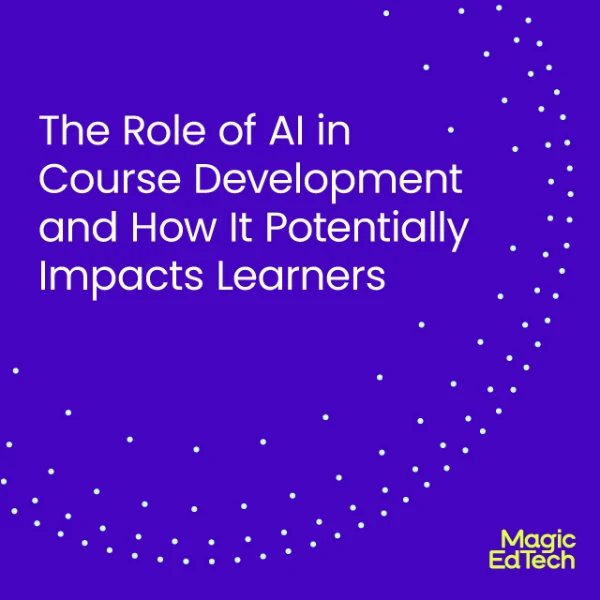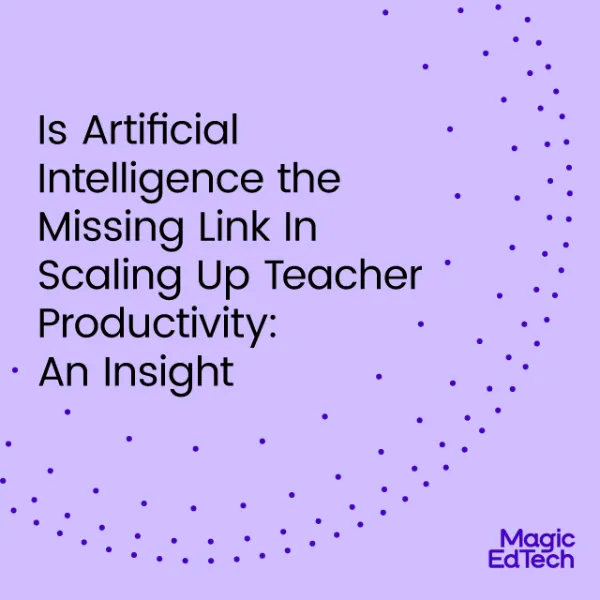8 Critical Evaluations Before Adopting AI for Higher Education
- 15 June, 2023
- Reading Time: 6 mins
“Technology will never replace great teachers, but in the hands of great teachers, it’s transformational.” – George Couros
Higher education is experiencing a transformative shift. Universities and colleges are grappling with challenges such as financial pressures, mental health concerns, and the need to bridge skill gaps while striving to maintain academic quality and accessibility. These changes are revolutionizing the way we teach and learn, and one technology that stands out as a catalyst for innovation in higher education is artificial intelligence (AI).
In this article, we explore what higher education decision-makers need to know about AI. We cannot deny that while AI will not automate everything, there are avenues where it will speed up processes. We will see it slowly being adopted across the spectrum of education and workforce learning.
- According to a report by HolonIQ, the global AI in the education market is expected to reach $6 billion by 2025, with AI applications enhancing learning outcomes and administrative processes.
- Institutions like Georgia State University have successfully implemented AI-based advising systems that have increased student retention rates by 15%.
1. Will AI Fuel Your Strategic Goals?
Incorporating artificial intelligence (AI) into higher education serves a specific purpose. AI interventions can directly impact student performance by improving graduation rates, retention rates, and academic achievements.
Its impact on operational efficiency won’t be lost as AI can reduce paperwork, automate workflows, and streamline administrative processes, resulting in saved time and resources.
As AI becomes more and more commonplace, it can directly aid the strategic goals of the organization. The burden of manual labor lightens, resource allocation is optimized, and administrative overhead diminishes. Universities and colleges will know more about their students than ever before and will be able to provide for their needs at lower price points.
Implementing AI in higher education involves costs; evaluating the return on investment (ROI) will be key to measuring success.
2. Will AI Tools Really Benefit Teaching and Learning?
AI offers various exciting use cases in the field of teaching and learning. We touched more upon this in our article on AI for teacher productivity. It can help teachers manage their workload and time by automating grading, research, and providing administrative support.
Within higher ed, the possibilities for AI in learning too are vast. Adaptive learning platforms are made more feasible with AI; personalizing educational content based on individual student needs. But balancing the power of AI with a human touch is essential to harnessing its benefits effectively.
There’s also the question of adoption. User experience plays a crucial role in successfully adopting AI in education. AI tools should be intuitive, user-friendly, and accessible to all users, including individuals with disabilities.
User experience encompasses the ease of interaction with AI systems and the training and support provided to educators and learners. Universities that successfully do this may gain a competitive advantage, attracting more students. Thus, failure to adopt AI due to poor UX can result in diminished competitiveness, reduced student outcomes, and limited institutional growth in the long run.
3. Do I Have Control Systems for Good Data Governance and Responsible AI?
There is scope for AI models to be trained based on the data that comes from user interactions. These models require large amounts of data to learn and make accurate predictions or recommendations. Without the right data, the university may miss out on valuable insights into student performance, learning patterns, and trends. This can impede evidence-based decision-making and hinder the implementation of proactive interventions for student success.
Data-driven decision-making is becoming increasingly important in higher education. You can gain valuable insights to improve educational outcomes by leveraging AI and analyzing data effectively.
Also, as AI becomes more prevalent in education, it is crucial to prioritize ethical considerations. You must develop AI tools to respect user privacy, ensure data security, avoid biases and discrimination, and comply with legal and ethical standards.
Recent incidents have highlighted the importance of responsible AI implementation. By adopting ethical guidelines and practices, higher education technology experts can ensure that AI empowers humans rather than replacing them. Feedback and iteration foster a collaborative environment where users’ voices are heard, and their experiences shape the development and enhancement of AI tools.
4. How Does Our Existing Ecosystem Integrate and Accommodate AI?
Integrating AI into existing systems and platforms is crucial for a smooth implementation. Compatibility with learning management systems and other tools used by technology architects should also be considered.
Seamless integration of AI technologies enables your tech experts to leverage their existing infrastructure and enhance it with AI capabilities. It will improve efficiency, streamline processes, and provide a more cohesive user experience for students, faculty, and staff.
5. How Can We Ensure Scalability and Maintenance of AI Systems for Sustainable Success?
As technology leaders at an institute, you must assess if the AI tool can handle the expected interaction volume and user load. Additionally, you must consider the maintenance requirements, including regular updates, bug fixes, and technical support.
Ensuring long-term success involves designing AI solutions that can grow with the institution’s needs. By planning for scalability and establishing effective maintenance procedures, you can maximize the benefits of AI and provide sustainable support to your educational ecosystem.
6. Are We Prepared for Legal and Regulatory Compliance?
You must ensure your AI tools comply with relevant laws, regulations, and guidelines. This includes data protection laws (e.g., GDPR), privacy regulations, accessibility guidelines, and intellectual property rights.
By navigating the AI landscape responsibly, you can build trust and maintain the integrity of your AI initiatives.
7. Are Our Incumbent Vendors Equipped to Provide the Right AI Support?
You should conduct thorough research, considering vendors’ track records, reputations, customer reviews, and levels of support. Engaging in conversations with vendors helps align AI strategies with their product roadmaps and commitment to data privacy and security.
Collaborating with reliable AI partners enhances the likelihood of a successful implementation. Vendors prioritizing data privacy, security, and long-term partnerships can provide your in-house tech team with the necessary expertise and support to achieve their AI goals.
8. Have We Conducted Enought Pilot Testing and Evaluation?
Before fully deploying AI tools, you should consider conducting pilot tests. Pilot testing allows them to gather feedback, evaluate effectiveness, identify potential challenges, and make necessary adjustments. This iterative approach increases the chances of success when implementing AI at scale.
Conclusion
As AI revolutionizes higher education, IT solution architects must embrace this transformative technology. Some of the future trends for AI in higher education include:
- Immersive learning with AI will be enhanced, making education more engaging and interactive.
- Artificial Intelligence in teaching and learning will open doors for personalized guidance and support for students
- AI and higher education will provide real-time assistance to students, answering their questions and offering valuable insights.
- Machine learning and higher education will be crucial in analyzing data and patterns to provide personalized learning experiences.
AI is reshaping the future of education, continually improving and adapting to meet the evolving needs of learners in higher education. Embrace the power of AI with Magic EdTech and propel your existing tech stack into a future where technology optimizes education.
To know more about our offerings, visit here





